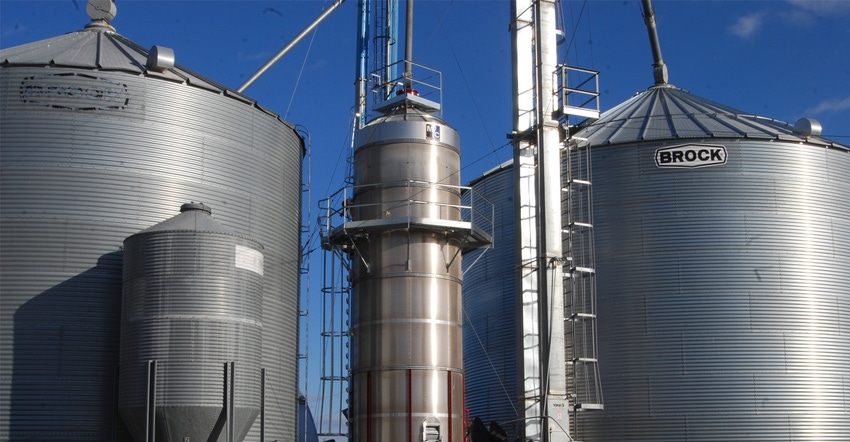November 1, 2019

With average day and night temperatures of 35 to 40 degrees F or cooler, the time is right to run the bin fans and cool down any corn or soybeans that went into the bin at higher temperatures. Iowa State University Extension ag engineering specialists Kristina TeBockhorst and Shawn Shouse offer the following tips for cooling and storing grain through the winter.
A good rule of thumb is to cool grain any time the average air temperature is around 20 degrees cooler than the grain temperature. Repeat this cooling cycle until the grain temperature is 30 to 40 degrees for winter storage. This storage temperature minimizes insect activity and mold growth in stored grain. Cooling grain below 30 degrees F has little added benefit and can cause ice to form in the grain. Air humidity makes little difference when cooling grain.
Keep an eye on cooling
When cooling grain, the cooling front moves through the bin in a wave, so grain temperature where the air exits will stay fairly steady until the cooling front gets there. The hours required for cooling the whole bin can be estimated as 15 divided by the cubic feet per minute of airflow per bushel of grain in the bin (cfm/bu.). If you don’t know how much airflow per bushel your fan provides, you can estimate it using the calculator from the University of Minnesota.
Select the crop stored, choose fans and enter the bin parameters; then find the airflow (cfm/bu.) for the grain depth that you have stored in the bin. For bins set up for drying, a cooling front may pass through the bin in less than one day. Bins with only small aeration fans may require a week or more. For example, if the fans provide 0.15 cfm/bu., then the time for cooling the bin would be 15 divided by 0.15 equals 100 hours, or about four days.
‘Core’ the bin
It’s always a good idea to “core” the grain just after filling the bin by removing about half the peak height. Leveling the top of the grain and removing the fines accumulated in the center of the bin will improve aeration and storage quality. If the top of the grain does not show signs of an inverted cone after coring, beware of grain bridging and do not enter the bin until the bridging has been corrected. Find more information on grain bridging and other grain storage hazards here.
The allowable storage time (shelf life) of corn nearly doubles with a reduction in grain temperature from 50 to 40 degrees. This can allow drying to stop at a higher moisture and still be stored through winter.
For example, 17% corn has a storage life of 5.3 months at 50 degrees, but 9.4 months at 40 degrees. Soybean storage properties are about like corn that is 2% drier. In other words, 15% soybeans store about like 17% corn. For the table of storage times and temperatures, visit ISU Extension.
After the final cooling cycle in the fall, remember to cover the fans to prevent warm air, rain or snow from entering the bottom of the bin. While properly dried and cooled, grain should store well through the winter. Be sure to check stored grain weekly through winter and spring. Be alert for any signs of spoilage or problems developing.
Source: ISU, which is solely responsible for the information provided and is wholly owned by the source. Informa Business Media and all its subsidiaries are not responsible for any of the content contained in this information asset.
You May Also Like




